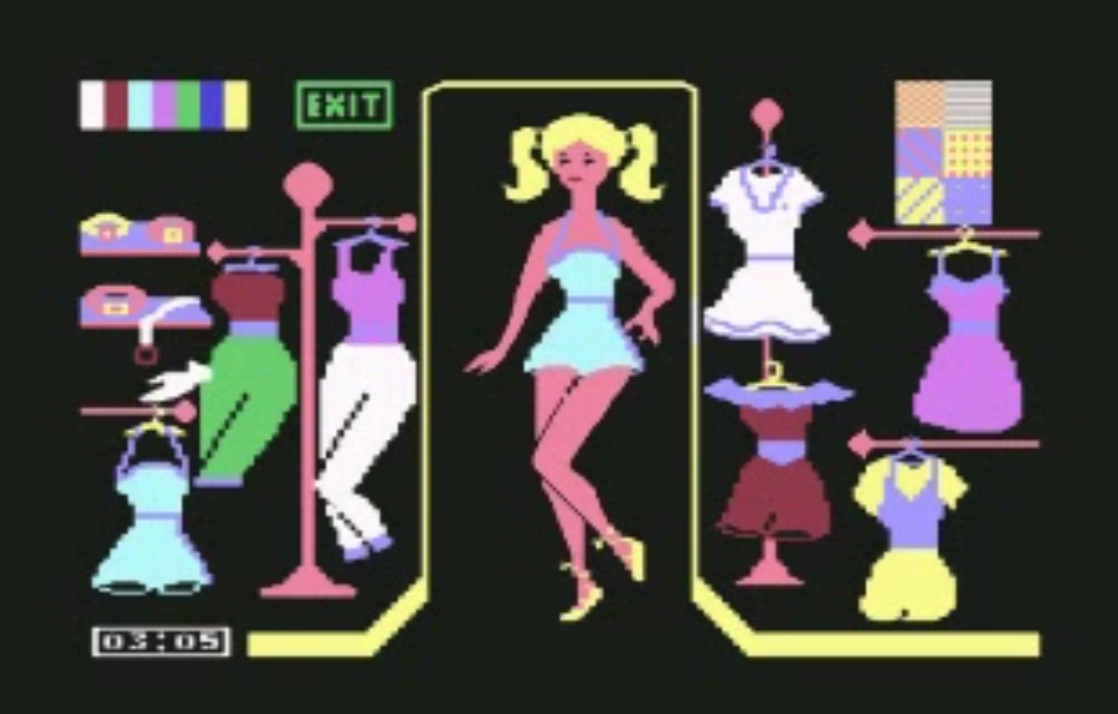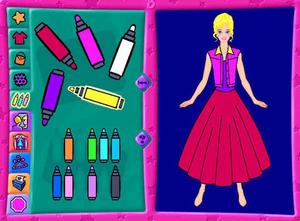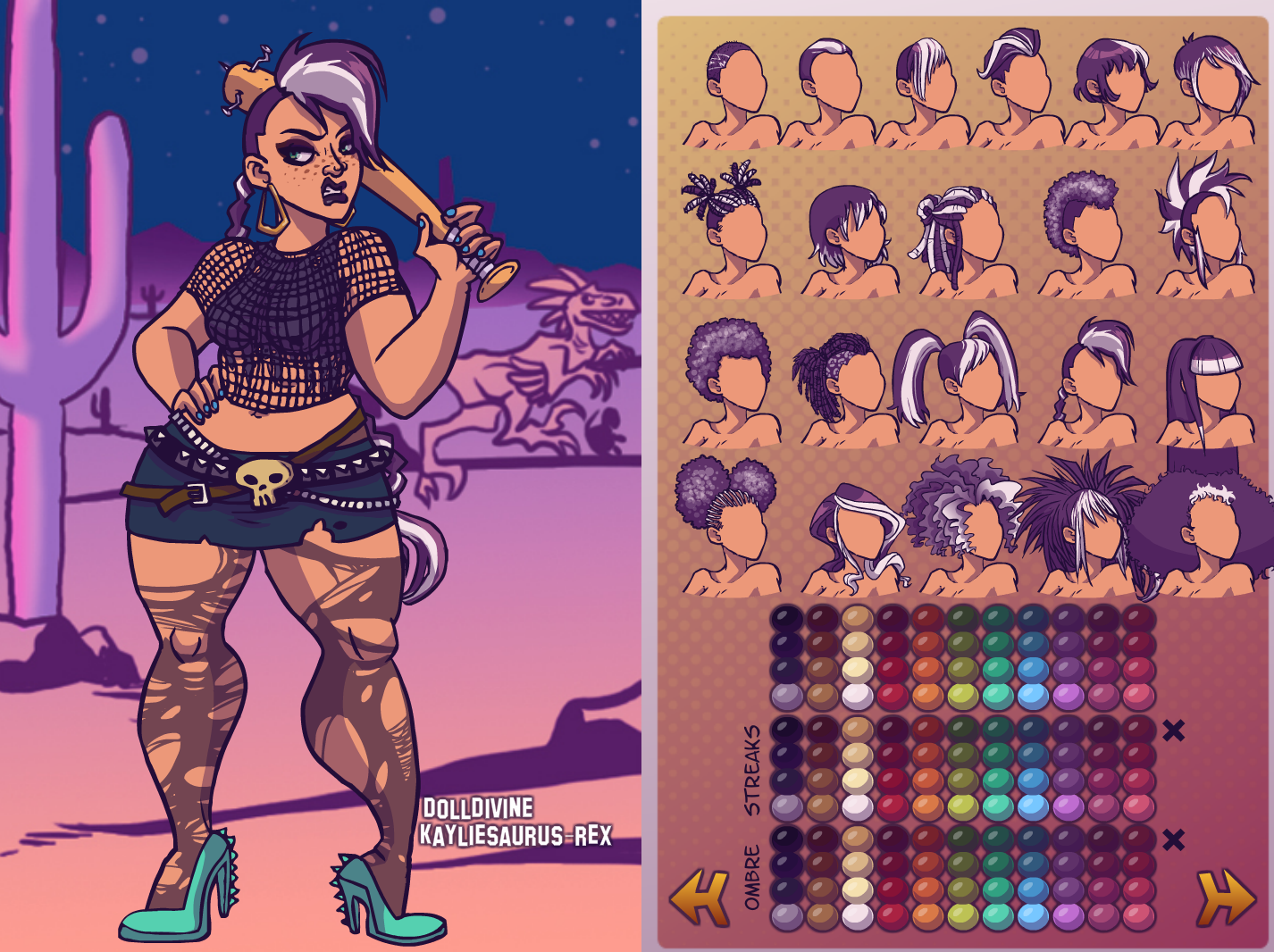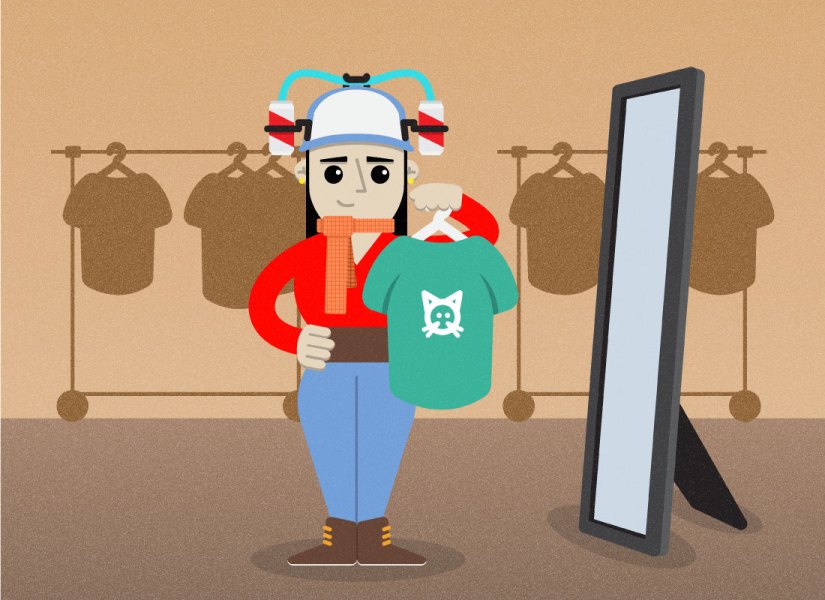This piece is part of our Future of Genre series. Read more here.
1: A Brief History of the Dress-Up Game
The dress-up genre is characterized by unbelievable shittiness. Flash interfaces residing on domains with names like game2girls.com, games with titles like “Pretty Princess Makeover” or “Justin Bieber Photography.” “Help this royal misfit with a makeover so she can become a very pretty princess,” reads the description for a gamesgogirls.com production titled “The Ugly Princess.” I wish I made that up.
Stand alone dress-up games operate under the assumption that their audience has a one-track mind. Because do girls even like anything other than princesses, fluffy puppies, baked goods and pink everything? Crappy flash games “for girls” are not unique in their problematic gender overgeneralization, and this hyper-feminization isn’t even the worst part. The larger problem is the scarcity of quality games about femininity; this just happens to include standalone dress-up games. The unbelievable shittiness of dress-up games is their own, a unique blend of design choices that exclude all player agency and creativity. Dress-up should not mean reassembling the pieces of an outfit drawn in full.
Dress-up is a pillar in videogaming: Ever created an avatar? Customized your armor? You’ve played dress-up. But standalone dress-up interfaces targeted towards female-identifying audiences are different. These interfaces are similar in design to the dress-up games children raised as girls are conditioned to play. Play reinforces the expectations attached to birth-assigned sex: boys to army men, girls to dolls. Unlike action figures, where clothing is typically painted on, dolls anticipate play revolving around dressing and undressing the figure. Toys are sold to girls, not as figures in a set, but as figures where play depends on auxiliary accessories for the main figure. You roleplay with a doll in part through dressing and undressing her. The outfit she wears helps to dictate the role she plays, but accessories sold with dolls have always narrowed optimal creativity. The best accessory is player imagination, because dolls can only be teachers, babysitters, and infants so many times before it gets boring. The limiting aspects of dress-up tools survived the digital shift. Dress-up in the digital age produced a niche subset of games where player imagination is constrained even further.
Standalone dress-up games have a long, mediocre lineage. In the early 90s, the Kisekae System Sets (called KiSS) gained popularity thanks to early internet communities of Japanese computer hobbyists and manga enthusiasts. The inspiration for these drag-and-drop dolls came from Kisekae (meaning “to dress” in Japanese) physical paper doll sets. The computer counterparts feature a lingerie-clad doll template and a small, often suggestive, wardrobe; each item clicks into place once you drag it on to the doll, thus “dressing” her. In an early essay, Eric Zimmerman and Elena Gorfinkel point out that KiSS games are implicitly adult in nature, as “the open-ended play of paper dolls shifts into a game of interactive striptease.” Often, KiSS games were not about creatively using clothing, but the sexual allure of an illustrated girl.

KiSS games worked similarly to their paper inspiration. Paper dolls date back as far as 900 AD, making them the oldest toys specifically for playing dress-up. They come in sets including a blank doll template and tabbed paper garments that fold onto the two-dimensional doll. Ruth Handler, mother of Barbie, originally created the iconic plastic bombshell to solve the limitations of these paper dolls. A three-dimensional doll allowed children to roleplay after dressing the figure. Barbie was born to wear clothes, a destiny fulfilled during her heyday in the 80’s and 90’s, when Barbie’s brand exploded with playsets, plastic shoes and militant hot pink advertising. In 1996, it was reported that 99% of girls ages 3-10 had at least one Barbie. Mattel’s leading girl-oriented franchise had the undivided attention of half the toy-buying market.
Naturally, Mattel was one of the first companies to start producing what tech and culture critic Justine Cassell refers to as “Pink Software,” games designed with stereotypical girly motifs. Mattel’s first Barbie title was a dress-up game creatively named Barbie. The plot is this: Ken gives you a call and asks you out on a date; you then go shopping, picking situational garments appropriately. This design uses clothing as puzzle pieces, where a correct combination triggers a new puzzle. Barbie is bad for the same reasons most dress-up games are bad: you’re simply slotting clothes onto a human figure thoughtlessly.
Mattel got it right in 1996 with the Barbie Fashion Designer. Fashion Designer blurred the lines of virtual and physical dolls by allowing players to print their clothing creations, enabled by special fabric sheets included with the game. To dress Barbie in the printed clothes, you had to cut and tape the templates together, much like traditional paper dolls. Even if players did not have a printer, Barbie would wear their custom designs in a 3D fashion show animation. The virtual fashion show was far superior to dressing physical Barbie in the printed garments, which were flimsy and impractical outside of the game. Unlike Barbie, there was no illusion of customization through matching situation-specific garments. Players edited the colors and patterns of the two-dimensional templates. Fashion Designer succeeded because clothing patterns were designed to be printed: players had control of the clothing itself, not just the clothing worn by a figure.

The game was so successful it set new records for PC game sales at the time, churning out half a million copies in the first two months after it was released. Unfortunately, since Fashion Designer, the quality of Mattel’s predominantly horse-based Barbie games has plummeted. The quality of dress-up games remained stagnant for some time. You won’t find dress-up innovation on a disc or cartridge at Gamestop. The handful of mediocre titles for the DS and console, even the acclaimed Imagine: Fashion Designer series or My Dress-Up, share shittiness similar to Mattel’s first dress-up title, as do the majority of sloppily designed dress-up games littering the Internet. But, despite the hundreds of subpar flash games giving the genre a bad name, the dress-up game is experiencing a revolution, and it is, in fact, browser-based. The evolution began in the early 2000s, a dress-up era epitomized by Dollz and Liisa’s Paper Doll Heaven.
If you never played with Dollz, I’m sorry: you missed out on a great part of Internet history. The browser-based makers featured drag-n-drop interfaces cluttered with hundreds of tiny items struggling to load on a single page. The process was a total pain in the ass and the clothes looked like they came from the closet of an uninspired mall-rat. The shift to games with more manageable interfaces similar to KiSS happened shortly after the height of Dollz’ popularity. Liisa’s Paper Doll Heaven was one of these early sites. The drag-n-drop dress-up destination was founded by Liisa Wrang, a retired Finnish woman who taught herself how to take a lifelong love of drawing paper dolls from her sketchbook to Geocities. Liisa’s celebrity-inspired doll makers attracted enough attention to pique the interest of investors. Ten years and millions of dollars later, Liisa’s Paper Doll Heaven transformed to Barbie 2.0: Stardoll.com. Stardoll is more than just dress-up. It is now a pay-to-play MMO boasting millions of active users dressing their MeDolls in real-life brands and displaying unworn items in customizable digital doll suites.
The mechanics of playing dolls and dress-up have come a long way since their paper beginnings. However, Barbie, Dollz, Stardoll, flash dress-up and all tenants of the pink toy aisle remain stubbornly consistent in their representation of women. The default doll is painfully thin and always white. Dolls of color are almost always sidekicks to the blonde star of the show. Bodies other than a slim, idealized hourglass are not made into dolls. The slender aryan standard of feminine beauty dominates the representation of women everywhere, an impossible ideal reinforced through the tools of play, from videogames to dolls. This narrow-minded vision of beauty hurts everyone, particularly the children who grow up playing with toys that teach their appearance as undesirable and secondary to true beauty. Dolls limit play, creativity and representation. The shittiness in their design runs deep.
2: The Dress-Up Game Grows Up
Like Ruth Handler and Barbie, dress-up innovation had to come from dissatisfaction with this shitty past. Ever since suffering through a dial-up connection to play Dollz, I sporadically google “dress-up games” hoping to find something better than my low expectations. I was pleasantly surprised during one of these most recent trips, when I stumbled on an elaborate game clearly concocted by a dress-up fan. That game is Rinmaru’s Videogame Avatar Creator, and it puts Dollz and Stardoll to shame.
Rinmaru has ingeniously reclaimed the genre to enable maximum creativity. The only in-game avatar creator with comparable open-ended customization is in the Mass Effect series. In Rinmaru’s Avatar Creator, you can change everything—everything—on the doll. The majority of objects are not packaged single items. You don’t change the shirt; you change the neckline, the torso, the left sleeve, the right sleeve, the shoulder armor, the torso armor. We’re not even at the pants, skirts, capes or shoes yet. Even the hair is in five sections, each with a dozen options and 29 hair colors. Avatar Creator’s fragmented design encourages players to mix and match basic pieces, yielding endless dress-up combinations.

Rinmaru Games, hosts dozens of dress-up games, visual novels and dating sims made by her and her cousin. Unlike KiSS, Dollz and Liisa’s Paper Dolls, Rinamaru’s games are not drag-n-drop. Instead, elements appear on the template after being clicked in the item console. Unlike drag-n-drop, this design enables players to edit and then layer isolated garment elements. The hundreds of pieces are relatively basic, so everything fits together. I asked Rinmaru how she ensured open-ended options in her games, and her response was delightfully straightforward: “I just place myself in the shoes of the player and try to add as many options as I can and then some.”
Rinmaru is not the only designer making innovative Flash dress-up games. Like Rinmaru, Ola Rogula was dissatisfied with existing dress-up games. This led Ola, a former geneticist, to establish Doll Divine. “I’m one of those artists that got tricked into programming by making graphics in Flash, and adding code bit by bit,” says Ola, who, despite her scientific background has always dabbled in internet graphics. “When the shift from pixel to Flash-based dolls started, I thought, ‘Oh cool … I could probably make one of these, but better.’” Ola, too, has created dozens of games in the vein of Fashion Designer and Avatar Creator. While Rinmaru primarily uses a manga-inspired aesthetic, like KiSS games, Ola works with a variety of different artists, including fellow doll-maker Azalea. “What usually happens is the artist will draw as many items as is fair in the budget, or they have time for if it’s a collaboration. Then, as I put the game together, I keep getting ideas for other items and features to add,” Ola explains. Each of her games takes about 6 months to make.
Their games are hugely popular: Doll Divine alone boasts 101,000 active users, who save and rate dolls in community galleries. Some players make dolls from their favorite media; others make OCs (original characters) with an imaginative story attached. No two dolls are the same. Fans of Ola and Rinmaru have even learned to edit a doll themselves if they desire an element not offered in the maker. These designers ensure they have a transparent creation process, which inspires players to edit dolls outside of the maker interface.
Both Ola and Rinmaru share a deep respect for their fans; one way this manifests itself is by not overgeneralizing them and assuming they must desire games about “girly” topics. Only a handful of makers revolve around stereotypically feminine themes like weddings; most are done in the style of popular fandoms or sci-fi and fantasy tropes. There’s a Hogwarts Maker, a Game of Thrones Maker, a Lord of the Rings maker.
Dress-up games didn’t just need a thematic makeover. Ola’s games start with randomized features, contrary to conventional white doll defaults. Ola and Rinmaru provide almost as many skin colors as hair colors. Ola’s recent release of the Dinogeddeon maker (based off the webcomic by Kayliesaurus featuring a dino-riding girl gang—think Tank Girl meets The Flintstones) features a dress-up game first: three different body types. Ola’s current designing method makes using different body types a little time-consuming, as clothing items must be redrawn to fit different templates. But she’s working to streamline the process, because the results are worth it.

Playing dress-up never meant customizing your doll. Makers focused on the template or the clothes, but never both. In solid early dress-up games like Fashion Designer or Liisa’s original paper dolls, players are confined to a single doll template. Expansive avatar makers in games like The Sims and Mass Effect focus on fine tuning facial features and physical attributes, leaving clothing as something secondary. Ola and Rinmaru make games where you can finally customize it all. This innovation affects more than the dress-up genre. It’s important for games as a whole. Videogames allow you to do just about anything: kill dragons, steal a car, fly around in space, go back in time. Videogames render these worlds with uncanny realism, worlds where you can do whatever you want, unless you want to be a woman.
When I asked Ola and Rinmaru about the other kinds of games they played, they both had similar answers. “I love games, but I have really niche tastes, so there isn’t a lot out there for me,” Ola says, listing her preferences as point-and-click adventure and RTS games. Rinmaru cites RPGs like Mass Effect, KOTOR and Final Fantasy as her favorites, but also adds, “I just wish there were more games with female leads. I mean It’s fine to play as a guy once in a while, but I’m a girl and I want to play as a girl.”
Rinmaru is not alone in her frustration. The amount of well-made, large scale games about femininity is pathetic, in that there are almost none as respected as their masculine counterparts. Those that do exist are either not taken seriously by the larger industry or are more concerned with creating an endlessly profitable system than telling a good story or creating an interesting world.
If you are anyone other than a straight, white, cisgendered male, you are accustomed to being left out of videogames. Playing games as a woman means a lack of agency in your virtual representation. We are not fairly represented in games, and we are repeatedly made unwelcome in the surrounding game culture. Games with a female avatar option are still narratives which reek of hyper-masculinity. As with dress-up games, the sole problem is not the narrative theme. The real problem is that games have fallen into a pit of lazy play driven by traditional masculinity; driving, fighting, killing. There are no tags or categories on Steam for Fashion or Makeup. There are, however, tags for “Not a Game” and “Walking Simulator.” We are constantly innovating our approach to playing and yet play coded as feminine is still systematically disparaged, overlooked, and undervalued.
With luck, the future of the dress-up genre will coincide with the future of the artform as a whole—an artform that has increasingly shed the stigma of different ways of playing, following the lead of titles such as Gone Home and Papers, Please. Doing this means actively fighting to include people who want to make and play sweeping, popular games about more than dragons, explosions, space ships and guns. It means the death of the perpetually sexually available, scantily clad, empty digital dolls in every genre.
Header by Zach Kugler
